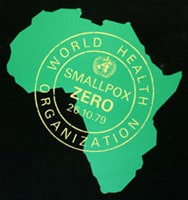The Spread and Eradication of Smallpox
Smallpox began causing illness and death more than a thousand years ago. Follow its spread and eventual eradication in the timeline below.
A written description of a disease that clearly resembles smallpox appears in China

In China, people appealed to the god Yo Hoa Long for protection from smallpox. Image taken from Recherche sur les Superstitions en Chine (Research on Chinese Superstitions) by Henri Dore, Shanghai, 1911-1920. Bibliotheque nationale de France.
Increased trade with China and Korea introduces smallpox into Japan.

Drawing of a woman defeating the “smallpox demon” by wearing red. A myth commonly believed around the world advocated that red light would cure smallpox. In Japan, families who fell sick with smallpox set up shrines to the “smallpox demon” in their homes with the hope they would appease the demon and be cured. By Sensai Eitaku (鮮斎永濯, Japanese, *1843, †1890) – scanned from ISBN 978-4-309-76096-4., Public Domain]
Smallpox is widespread in India. Arab expansion spreads smallpox into northern Africa, Spain, and Portugal.

Figurine of Indian smallpox goddess Shitala Mata worshipped in northern India. She was considered both the cause and cure of smallpox disease. Symbolically, she represents the importance of good hygiene in people’s health and motivates worshipers to keep their surroundings clean. Photo courtesy of the National Library of Medicine.
Smallpox spreads to Asia Minor, the area of present-day Turkey.

The map shows the Ottoman Empire in 1801, which then extended from Turkey (Anatolia) to Greece, Hungary, Bulgaria, Romania, as well as northern Africa and parts of Middle East. Smallpox is thought to arrive to the area from Asia through major trade routes, like the Silk Road.
Entrance into Europe
Crusades further contribute to the spread of smallpox in Europe with the European Christians moving to and from the Middle East during the next two centuries.
Smallpox moves north
Population expansion and more frequent travel renders smallpox endemic in previously unaffected Central and North Europe, with severe epidemics occurring as far as Iceland.
Smallpox is widespread in many European countries, and Portuguese expeditions to African west coast and new trade routes with eastern parts of Africa introduce the disease into West Africa.

Statue of Shapona, the West African god of smallpox. Smallpox was thought to be a disease forced upon humans due to Shapona’s “divine displeasure,” and formal worship of the god of smallpox was highly controlled by specific priests in charge of shrines to the god. People believed that the priests themselves were capable of causing smallpox outbreaks. Even though the British colonial rulers banned the worship of Shapona in 1907, worship of the deity continued. Source: CDC, photo credit James Gathany.
European colonization and the African slave trade import smallpox into the Caribbean and Central and South America.

Illustration by the Franciscan missionary Bernardino de Sahagun who wrote detailed accounts of the Aztec history during his life there from 1545 until his death in 1590 into 12 books entitled “General History of the Things of New Spain.” Introduction of smallpox into Mexico by the Spanish around 1520 was one of the factors that led to the demise of Aztec Empire. Scanned from (2009) Viruses, Plagues, and History: Past, Present and Future, Oxford University Press, USA, p. 60. Public Domain.
Variolation—a process of grinding up dried smallpox scabs from a smallpox patient and inhaling them or scratching them into an arm of an uninfected person—is being used in China (inhalation technique) and India (cutaneous technique) to control smallpox.

A container from Ethiopia used to store the powdery variolation material, which was produced by grinding up dried smallpox scabs taken from a smallpox patient. Source: CDC, photo credit Brian Holloway.
Increased use of variolation
Variolation (cutaneous technique) is a widespread method for preventing smallpox in the Ottoman Empire (former Asia Minor, present-day Turkey) and North Africa.
Smallpox spreads into North America
European colonization imports smallpox into North America.
Variolation is introduced into England by Lady Mary Wortley Montagu, the wife of the British ambassador to Turkey.

Lady Mary Wortley Montagu, the wife of the British ambassador, learned about variolation during their appointment in Turkey. A survivor of smallpox herself, she had both of her children variolated and was the foremost person responsible for the introduction of the technique to England.
In 1796, Edward Jenner, an English doctor, shows the effectiveness of previous cowpox infection in protecting people from smallpox, forming the basis for vaccination.

Edward Jenner (1749–1823). Photo courtesy of the National Library of Medicine.
Smallpox is widespread in Africa, Asia, and South America in the early 1900s, while Europe and North America have smallpox largely under control through the use of mass vaccination.

The map shows the worldwide distribution of smallpox and the countries in which it was endemic in 1945. Source: CDC, photo credit Dr. Michael Schwartz.
After a global eradication campaign that lasted more than 20 years, the 33rd World Health Assembly declares the world free of smallpox in 1980.

WHO poster commemorating the eradication of smallpox in October 1979, which was later officially endorsed by the 33rd World Health Assembly on May 8, 1980. Courtesy of WHO.

